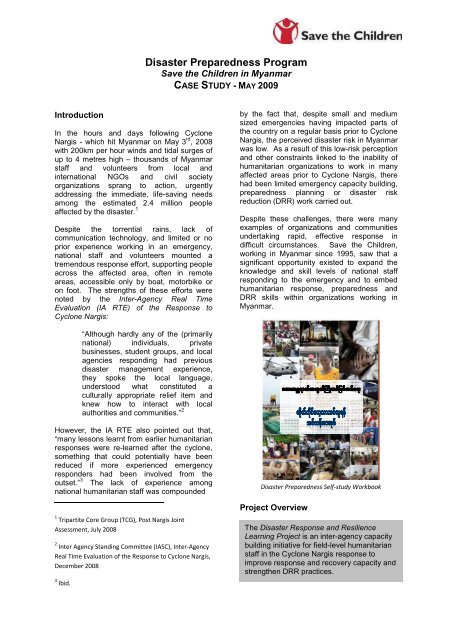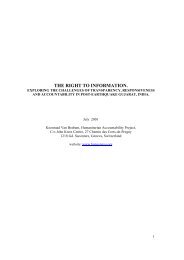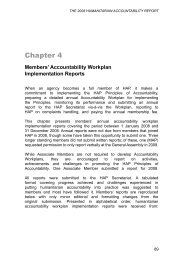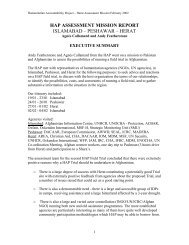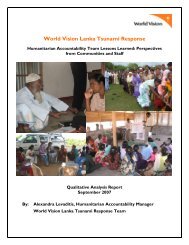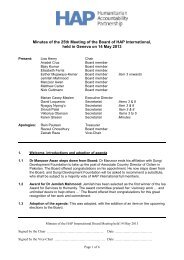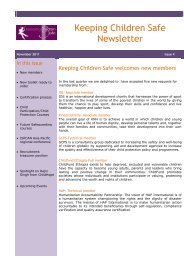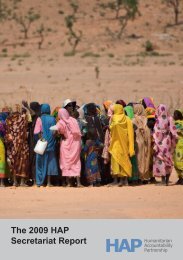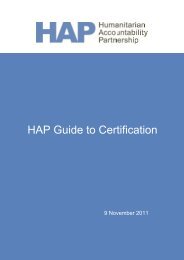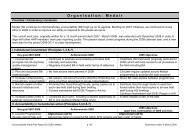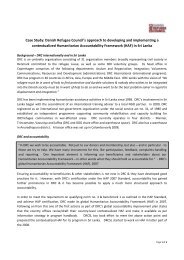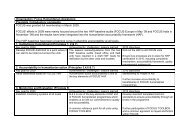Disaster Preparedness Program Case Study ... - HAP International
Disaster Preparedness Program Case Study ... - HAP International
Disaster Preparedness Program Case Study ... - HAP International
Create successful ePaper yourself
Turn your PDF publications into a flip-book with our unique Google optimized e-Paper software.
Introduction<br />
In the hours and days following Cyclone<br />
Nargis - which hit Myanmar on May 3 rd , 2008<br />
with 200km per hour winds and tidal surges of<br />
up to 4 metres high – thousands of Myanmar<br />
staff and volunteers from local and<br />
international NGOs and civil society<br />
organizations sprang to action, urgently<br />
addressing the immediate, life-saving needs<br />
among the estimated 2.4 million people<br />
affected by the disaster. 1<br />
Despite the torrential rains, lack of<br />
communication technology, and limited or no<br />
prior experience working in an emergency,<br />
national staff and volunteers mounted a<br />
tremendous response effort, supporting people<br />
across the affected area, often in remote<br />
areas, accessible only by boat, motorbike or<br />
on foot. The strengths of these efforts were<br />
noted by the Inter-Agency Real Time<br />
Evaluation (IA RTE) of the Response to<br />
Cyclone Nargis:<br />
<strong>Disaster</strong> <strong>Preparedness</strong> <strong>Program</strong><br />
Save the Children in Myanmar<br />
CASE STUDY - MAY 2009<br />
“Although hardly any of the (primarily<br />
national) individuals, private<br />
businesses, student groups, and local<br />
agencies responding had previous<br />
disaster management experience,<br />
they spoke the local language,<br />
understood what constituted a<br />
culturally appropriate relief item and<br />
knew how to interact with local<br />
authorities and communities.” 2<br />
However, the IA RTE also pointed out that,<br />
“many lessons learnt from earlier humanitarian<br />
responses were re-learned after the cyclone,<br />
something that could potentially have been<br />
reduced if more experienced emergency<br />
responders had been involved from the<br />
outset.” 3 The lack of experience among<br />
national humanitarian staff was compounded<br />
1 Tripartite Core Group (TCG), Post Nargis Joint<br />
Assessment, July 2008<br />
2 Inter Agency Standing Committee (IASC), Inter-Agency<br />
Real Time Evaluation of the Response to Cyclone Nargis,<br />
December 2008<br />
3 Ibid.<br />
by the fact that, despite small and medium<br />
sized emergencies having impacted parts of<br />
the country on a regular basis prior to Cyclone<br />
Nargis, the perceived disaster risk in Myanmar<br />
was low. As a result of this low-risk perception<br />
and other constraints linked to the inability of<br />
humanitarian organizations to work in many<br />
affected areas prior to Cyclone Nargis, there<br />
had been limited emergency capacity building,<br />
preparedness planning or disaster risk<br />
reduction (DRR) work carried out.<br />
Despite these challenges, there were many<br />
examples of organizations and communities<br />
undertaking rapid, effective response in<br />
difficult circumstances. Save the Children,<br />
working in Myanmar since 1995, saw that a<br />
significant opportunity existed to expand the<br />
knowledge and skill levels of national staff<br />
responding to the emergency and to embed<br />
humanitarian response, preparedness and<br />
DRR skills within organizations working in<br />
Myanmar.<br />
<strong>Disaster</strong> <strong>Preparedness</strong> Self-study Workbook<br />
Project Overview<br />
The <strong>Disaster</strong> Response and Resilience<br />
Learning Project is an inter-agency capacity<br />
building initiative for field-level humanitarian<br />
staff in the Cyclone Nargis response to<br />
improve response and recovery capacity and<br />
strengthen DRR practices.
The <strong>Disaster</strong> Response and Resilience<br />
Learning Project was developed by Save the<br />
Children to enhance humanitarian capacity<br />
following Cyclone Nargis. Developed as an<br />
inter-agency initiative, the project<br />
implementation phase from March to October<br />
2009 is targeting 480 staff working with<br />
humanitarian organizations - ranging from<br />
small and community-based to large and<br />
international – to increase learning of concepts<br />
and principles related to humanitarian work,<br />
including DRR, disaster response,<br />
accountability and international standards.<br />
The project will be implemented in twelve<br />
cyclone-affected townships in Yangon and<br />
Ayeyarwady Divisions, selected for their<br />
spread across the cyclone-affected area and<br />
the proportion of both local and international<br />
organizations in operation. Funding for the<br />
project has been provided by the Danish<br />
<strong>International</strong> Development Agency (DANIDA)<br />
and the <strong>Disaster</strong>s Emergency Committee<br />
(DEC) in the UK.<br />
Human Resources<br />
The project team is comprised of 1<br />
international Project Manager, and 3 national<br />
staff in the roles of Learning & Development<br />
Manager, Learning Assessment Officer, and<br />
Project Assistant, with complementary skills<br />
and experience in project management,<br />
humanitarian work, HR and capacity building.<br />
A steering committee was formed with 10<br />
members representing Myanmar NGOs<br />
(MNGOs), <strong>International</strong> NGOs (INGOs) and<br />
local capacity building and networking<br />
organizations to provide feedback, advice,<br />
direction, recommendations and support which<br />
increased the ability of the project staff to<br />
develop appropriate approaches and activities.<br />
The monthly committee meetings also<br />
provided valuable opportunities for committee<br />
members to learn and share from each other’s<br />
experience in the Cylcone Nargis response.<br />
Identifying Needs<br />
A learning needs assessment was carried out<br />
by project staff in order to identify the learning<br />
needs and preferences of field-level<br />
humanitarian staff working on the Cyclone<br />
Nargis response. Eighty-three (83)<br />
respondents from MNGOs and INGOs in 2<br />
cyclone-affected townships completed a<br />
survey, providing important information which<br />
directly informed the objectives and approach<br />
of the project.<br />
From the survey it was evident that a great<br />
desire existed among the field-level<br />
humanitarian staff to increase their knowledge<br />
on a wide range of topics and to enhance their<br />
professional development. The challenge<br />
presented was therefore how to engage a<br />
large number of people from different<br />
organizations in a comprehensive learning<br />
process that would build upon their practical<br />
experience with minimal time away from their<br />
responsibilities on the response (thereby<br />
providing the opportunity for the interventions<br />
to be utilized in early response phases of<br />
future emergencies).<br />
Highlights of learning needs assessment:<br />
Prior to Cyclone Nargis:<br />
• 48% of respondents worked for a<br />
humanitarian organization<br />
• 29% had experience working in an<br />
emergency<br />
• 89% had never received training in<br />
emergency response, humanitarian<br />
principles, disaster preparedness<br />
Of the 46 potential learning topics presented<br />
(related to humanitarian principles, disaster<br />
preparedness and response, managing<br />
projects, working with communities and<br />
managing people) all of the topics were<br />
selected by more than 50% of respondents<br />
When asked about learning preferences, the<br />
majority of respondents selected (a) with a<br />
facilitator providing training in a workshop<br />
and (b) with a group of people discussing a<br />
topic rather than (c) on your own with a<br />
coach or mentor or (d) on your own with<br />
reading materials (workbook). When asked<br />
to consider the same question in the context<br />
of a response situation when they have<br />
many priorities and a limited amount of time,<br />
preferences for options (c) and (d) increased<br />
by 15% and 11% respectively.<br />
Innovative Learning Approach<br />
The project design utilized a relatively new<br />
approach, shifting the emphasis from the<br />
teacher-centred training approach commonly<br />
used in Myanmar to a participant-centred<br />
learning approach.<br />
Training refers to an instructor-led, contentbased<br />
intervention, leading to desired<br />
changes in behaviour, while learning is<br />
characterized by a self-directed, work-based<br />
process, leading to increased adaptive<br />
capacity.<br />
2
The approach built upon prior research from<br />
such initiatives as the Emergency Capacity<br />
Building Project and the Learning Support &<br />
Capacity Building <strong>Program</strong>me (RedR Sri<br />
Lanka), which recognized that traditional<br />
training programs are often not sufficient to<br />
equip national staff for emergency work and<br />
that specific learning approaches and ongoing<br />
support are required to enhance the learning<br />
process.<br />
The project’s innovative learning approach<br />
emphasizes the following elements:<br />
• Field-level focus and location: To meet the<br />
specific needs (knowledge and learning<br />
methods) which staff require during a<br />
response operation, ensuring immediate<br />
relevance and transferability to operational<br />
field work, and alleviating the time required<br />
to travel to HQ locations (e.g. Yangon)<br />
• On-the-job learning: A self-directed, workbased<br />
learning process requiring<br />
commitment and self-discipline to link the<br />
resources and information provided to<br />
practical experience<br />
• Peer support: To encourage staff to learn<br />
through their shared experiences and to<br />
utilize local networks for ongoing support<br />
• Personal reflection: To maximize<br />
experiential learning through reflecting<br />
back on it, drawing conclusions and<br />
deriving principles for future application<br />
Participants during peer learning activity<br />
Project Activities<br />
The activities and resources, developed<br />
specifically to support the project’s learning<br />
approach include: a self-study workbook,<br />
workshop, discussion group meeting, and<br />
exposure visit, which together comprise the<br />
<strong>Disaster</strong> <strong>Preparedness</strong> <strong>Program</strong>. All activities<br />
are conducted in the local Burmese language<br />
and the workbook and facilitation guides are<br />
available in both Burmese and English.<br />
<strong>Disaster</strong> <strong>Preparedness</strong> <strong>Program</strong>: tailor-made<br />
learning activities for field-level humanitarian<br />
staff<br />
Self-study workbook: Provides basic<br />
information about humanitarian principles<br />
and standards, disaster preparedness and<br />
response, project management and working<br />
with people. The workbook utilizes simple<br />
language and provides clear explanations<br />
designed to be accessible to a wide<br />
audience of Myanmar staff working with<br />
community-based, national and international<br />
organizations. It also includes reflective<br />
questions to help participants to apply and<br />
link the topics within their work.<br />
Workshop: Introduces many of the topics<br />
provided in the workbook through<br />
participatory methods and helps to build the<br />
participants’ comfort and confidence with<br />
using the workbook in a self-study manner<br />
(which they are expected to do following the<br />
workshop). During the workshop participants<br />
are encouraged to reflect on the topics and<br />
how they relate to their work experience, and<br />
to share this with each other.<br />
Discussion group meeting: Conducted 3<br />
weeks after the workshop, to provide<br />
participants with an opportunity to discuss<br />
their learning, ask questions, describe how<br />
they applied their learning to their work<br />
context, and to collect feedback on the<br />
workbook.<br />
Exposure visit: Provides an opportunity for<br />
the participants to visit another organization<br />
to observe and assess innovative activities,<br />
programming and alternate processes<br />
utilized by other organizations or programs<br />
working on the Cyclone Nargis response.<br />
Learning Facilitators<br />
Three facilitators have been hired on a<br />
contractual basis to conduct each month’s<br />
scheduled activities in 3 townships<br />
(concurrently). The facilitators bring significant<br />
levels of experience in teaching, training, and<br />
facilitation, and were provided with a Trainingof-Trainers<br />
(ToT) workshop on participatory<br />
facilitation skills, conducted by the Centre for<br />
Community Empowerment from Vietnam.<br />
Their experience coupled with their knowledge<br />
of the local context, enabled them to contribute<br />
significant ideas and techniques to the<br />
3
development of the<br />
project activities as<br />
well as to carry them<br />
out confidently while<br />
effectively engaging a<br />
diverse group of<br />
participants. The<br />
facilitators were not<br />
required to have<br />
significant<br />
humanitarian<br />
experience as a prerequisite<br />
for their work<br />
with the <strong>Disaster</strong><br />
<strong>Preparedness</strong><br />
Learning Facilitator<br />
<strong>Program</strong>.<br />
The facilitator’s role is to provide guidance and<br />
direction to support the participants to meet<br />
the learning objectives of the activities. Their<br />
role is therefore not to teach but rather to<br />
facilitate learning. The participants are<br />
considered the “experts” in humanitarian work<br />
as they have significant skills and experience,<br />
and the facilitator will help them to share this<br />
with each other. This is another significant<br />
shift in the learning approach used in<br />
Myanmar as the instructor is usually<br />
considered to be the expert on the topic and<br />
workshop participants are not expected to<br />
contribute to or question the learning process.<br />
Phase 1 in Kungyangon, Pyapon and<br />
Labutta<br />
Field visits were conducted by project staff to<br />
each of the three initial townships in order to<br />
identify the organizations working in the area<br />
and to utilize a personal, face-to-face<br />
approach to share information about the<br />
program and its benefits for staff. These visits<br />
were essential to ensuring a high level of<br />
participation in the program. They generated a<br />
significant level of engagement among staff<br />
and organizations and further enhanced the<br />
staff’s knowledge of the local context, allowing<br />
them a better grasp of the varied operating<br />
styles and capacity needs of organizations in<br />
the cyclone-affected areas.<br />
Staff representatives from Save the Children<br />
Area Offices and OCHA (Office for the<br />
Coordination of Humanitarian Affairs) Hub<br />
Offices in each township agreed to<br />
disseminate and collect application forms on<br />
behalf of the project. This was an effective way<br />
to overcome the lack of email and fax service.<br />
The application forms required applicants to<br />
indicate their motivation for participating in the<br />
program, and sign-off from their line manager.<br />
The programs in all 3 townships were oversubscribed<br />
– with a total of 202 applications<br />
received for 120 spaces (40 per township). All<br />
applications were thoroughly reviewed using<br />
criteria designed to ensure diversity of sectors,<br />
positions, organizations and gender.<br />
Workshop attendance in 3 initial townships:<br />
Kungyangon, Pyapon, Labutta<br />
• 120 participants from:<br />
o 15 Myanmar NGOs<br />
o 11 <strong>International</strong> NGOs<br />
o 4 UN/Inter-governmental<br />
agencies<br />
Applying knowledge from the workbook<br />
Participatory approach<br />
Exposure visit to shelter project<br />
4
Evaluation and Feedback<br />
Pre- and post-knowledge assessments were<br />
utilized in the workshops as a self-assessment<br />
tool for the participants to assess their level of<br />
understanding on the workshop topics prior to<br />
the workshop and again after they completed<br />
the workshop. The results of this process<br />
were collected by staff in a confidential<br />
manner and used to assess the increased<br />
knowledge of the participants as an outcome<br />
of the workshop.<br />
The results indicate that prior to the workshop<br />
most of the participants identified their level of<br />
knowledge on the workshop topics as okay,<br />
not well or not at all, however after<br />
participating in the two day workshop the<br />
number of responses in the excellent and very<br />
well categories increased considerably.<br />
At the end of the workshop, participants were<br />
asked to complete a short evaluation form to<br />
evaluate and provide feedback on the<br />
workshop. When asked to identify the 3 most<br />
significant things they learned in the workshop,<br />
the majority of responses were related to:<br />
humanitarian principles (55 responses),<br />
leadership (47 responses), and reducing risks<br />
and preparing for disasters (45 responses).<br />
Participants were also asked to indicate what<br />
other topics they would like to learn about and<br />
the most frequently cited topics were: project<br />
management (14 responses), disaster<br />
response and preparedness (14 responses),<br />
community-based and child-led DRR (8<br />
responses).<br />
Feedback on the self-study workbook was<br />
very positive and participants appreciated<br />
receiving the free resource which provided<br />
information on many new topics. Some<br />
participants noted that they had difficulty<br />
understanding some of the topics on their own,<br />
without the support of the facilitator or peers.<br />
The discussion group meetings therefore<br />
provided an important opportunity for follow-up<br />
discussion on specific topics.<br />
Interest in the exposure visits was very high<br />
among the participants, although many found<br />
it challenging to apply the information from the<br />
workbook and workshop to a practical context.<br />
Participants indicated that practical tools and<br />
templates would be very beneficial to helping<br />
them to apply their knowledge.<br />
Project staff have incorporated many of the<br />
suggestions from participants into the program<br />
and will continue to evaluate the learning<br />
outcomes.<br />
Results of pre- and post-knowledge assessments<br />
(for modules 1&2) from participants in 3 initial<br />
workshops:<br />
# of Participants<br />
# of Participants<br />
70<br />
60<br />
50<br />
40<br />
30<br />
20<br />
10<br />
0<br />
70<br />
60<br />
50<br />
40<br />
30<br />
20<br />
10<br />
0<br />
Participant Knowledge Assessment<br />
Module 1: Humanitarian Context<br />
Excellent Very Well Okay Not Well Not at All<br />
Level of Understanding<br />
Participant Knowledge Assessement<br />
Module 2: <strong>Disaster</strong> <strong>Preparedness</strong> & Response<br />
Excellent Very Well Okay Not Well Not at All<br />
Level of Understanding<br />
Workshop evaluation results:<br />
% of Participants<br />
% of Participants<br />
70<br />
60<br />
50<br />
40<br />
30<br />
20<br />
10<br />
70<br />
60<br />
50<br />
40<br />
30<br />
20<br />
10<br />
0<br />
0<br />
Content Facilitators Facility General<br />
Satisfaction<br />
Category of Evaluation<br />
Self-study Workbook evaluation results:<br />
Content Translation Presentation Exercises<br />
Category of Evaluation<br />
5<br />
Pre-workshop<br />
Post-workshop<br />
Pre-workshop<br />
Post-workshop<br />
Strongly Agree<br />
2<br />
3<br />
4<br />
Strong<br />
2<br />
3<br />
4<br />
Weak<br />
Strongly Disagree
Lessons Learned<br />
Combine innovative & traditional approaches:<br />
The rationale for developing a self-study<br />
workbook was to enable staff to learn on their<br />
own without taking them away from their work<br />
for significant periods but there was initially<br />
concern that the self-study approach would not<br />
be effective in Myanmar without a motivation<br />
such as a quiz or test. A decision was<br />
therefore made to use a traditional learning<br />
format (short workshop) to introduce, support<br />
and build confidence in the innovative<br />
approach (self-study workbook).<br />
Involve facilitators in activity design: Involving<br />
the facilitators in the development and review<br />
of the learning activities was very beneficial as<br />
they contributed local knowledge and<br />
experience and it also helped to enhance their<br />
commitment to the program.<br />
Draw on local expertise: The steering<br />
committee was an important resource for<br />
project development. Despite challenges with<br />
convening all members for meetings, the value<br />
of their contribution was high due to their<br />
expertise in emergencies, NGO context,<br />
training, etc. It was also imperative in the<br />
Myanmar context to consult with local contacts<br />
in each township to identify how to obtain<br />
permission from local government authorities<br />
to conduct training activities.<br />
Secure organizational buy-in: It was important<br />
to visit each township for face-to-face<br />
meetings with organizations before<br />
implementation began to establish<br />
relationships with managers and senior<br />
personnel who could encourage and support<br />
their staff to participate in the program.<br />
Encourage participant commitment: Requiring<br />
participants to provide their motivation on the<br />
application form prompted them to consider<br />
the program objectives and their interest in<br />
participating. This consideration helped to<br />
ensure individual commitment to the program<br />
and attendance at all 4 activities. Requiring<br />
sign-off from line managers on the application<br />
form helped to ensure accountability and<br />
support.<br />
Give time & flexibility to overcome challenges:<br />
Lack of communication technology (e.g.<br />
internet, fax) created challenges with regard to<br />
coordinating the program from Yangon (e.g.<br />
distributing and collecting application forms).<br />
Sufficient time had to be provided to send<br />
paper applications between offices and in<br />
some cases project staff needed to travel to<br />
the townships to collect them.<br />
Use consistent and transparent selection<br />
processes: Having clear selection criteria for<br />
identifying program participants was important<br />
because the programs have been<br />
oversubscribed and the criteria provided<br />
guidelines by which to short-list participants.<br />
The criteria were also used to explain to<br />
organizations and staff why some applicants<br />
were not selected. Similarly, selection criteria<br />
were also used to identify and provide<br />
explanation for the townships where the<br />
program will be implemented.<br />
Create opportunities for knowledge transfer:<br />
The strong interest participants expressed to<br />
transfer and share their knowledge and<br />
learning with colleagues and community<br />
members exceeded the expectations of project<br />
staff. Further consideration should be given to<br />
how the program can support this opportunity<br />
to expand its reach across the humanitarian<br />
sector and communities.<br />
Value staff time and experience: Working<br />
within the dynamic context of an emergency<br />
means that staff are constantly faced with<br />
urgent deadlines, impromptu requests and<br />
changing priorities, and this must be<br />
recognized and accommodated in order to<br />
support their participation in learning activities<br />
(e.g. when developing schedules, meeting<br />
locations, etc.). All staff regardless of their<br />
prior training or experience should be<br />
encouraged to contribute their ideas,<br />
knowledge and skills to enhance the learning<br />
environment.<br />
Promote learning for all staff in an emergency:<br />
Feedback from participants has indicated that<br />
there are some biases toward prioritizing<br />
humanitarian related training for program staff<br />
over support staff, however the foundational<br />
knowledge provided in this program is<br />
essential for all humanitarian and NGO staff –<br />
even those not directly engaged in front-line<br />
emergency work. It is also evident that<br />
training and capacity building opportunities<br />
have most often been provided for mid-/seniorlevel<br />
staff, thereby neglecting the learning<br />
needs of lower-level and front-line staff,<br />
particularly those based in the field. Convening<br />
a diverse group of staff from different roles,<br />
sectors and programs provided participants<br />
with valuable cross-learning opportunities.<br />
6
The Way Forward<br />
The initial results of the <strong>Disaster</strong> <strong>Preparedness</strong><br />
<strong>Program</strong> have been very positive and they<br />
have reinforced the need to continue to<br />
support the capacity building of humanitarian<br />
staff in Myanmar. As previously stated, the<br />
program is targeting 480 humanitarian staff<br />
working on the Cyclone Nargis response,<br />
however the learning needs of humanitarian<br />
staff in Myanmar remain far greater than what<br />
the current funded project (until October 2009)<br />
can address.<br />
Project staff are currently exploring<br />
opportunities to increase the reach of the<br />
<strong>Disaster</strong> <strong>Preparedness</strong> <strong>Program</strong> through a<br />
variety of means, such as:<br />
• Providing Training-of-Trainer (ToT)<br />
sessions and encouraging organizations to<br />
offer the program to their own staff<br />
• Promoting the program among nonemergency<br />
staff, as well as organizations<br />
and programs in other parts of Myanmar<br />
(outside the cyclone-affected area)<br />
• Establishing linkages with regional and<br />
international organizations and capacity<br />
building initiatives to adapt the materials<br />
and resources for other contexts and<br />
languages<br />
Following the experience of Cyclone Nargis,<br />
civil society organizations in Myanmar have<br />
noted that “staff feel more motivated to work<br />
when they feel confident about their skills and<br />
knowledge in doing the job” 4 and training<br />
sessions have been an integral way in which<br />
to enable staff to build their “sense of<br />
confidence in themselves”. They have also<br />
highlighted a significant need for capacity<br />
building and see external organizations as<br />
being well placed to assist. Through<br />
continued inter-agency collaboration and<br />
stakeholder engagement it is hoped that the<br />
<strong>Disaster</strong> <strong>Preparedness</strong> <strong>Program</strong> will continue<br />
to support the continuous learning of staff and<br />
the development of the humanitarian sector in<br />
Myanmar.<br />
4 Centre for Peace & Conflict Studies (Cambodia),<br />
Listening to Voices from Inside: Myanmar Civil<br />
Society’s Response to Cyclone Nargis, 2009<br />
<strong>Disaster</strong> <strong>Preparedness</strong> <strong>Program</strong> in Action<br />
Save the Children in Myanmar’s Human<br />
Resources Department is developing a<br />
new staff induction process that will utilize<br />
the self-study workbook and a customized<br />
version of the workshop, to employ a<br />
minimum competency in disaster<br />
preparedness for all country staff.<br />
<strong>Program</strong> participant receiving certificate<br />
For more information on the <strong>Disaster</strong><br />
<strong>Preparedness</strong> <strong>Program</strong>, please contact:<br />
Thanda Kyaw<br />
Learning & Development Manager<br />
<strong>Disaster</strong> Response & Resilience Learning<br />
Project<br />
Save the Children in Myanmar<br />
Email: tdkyaw@savechildren.org.mm<br />
Phone: +95-1-536 732, 537 092 x.106, 107<br />
7


